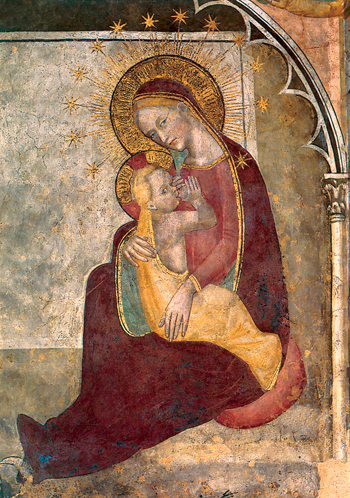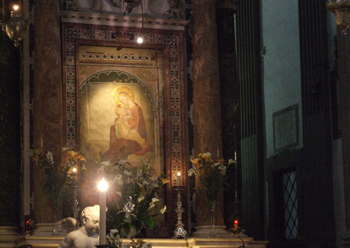Saints of the Day
 |
 |
 |
 |
 |
 |
 |
Our Lady of Humility (Madonna dell’Umiltà)
July 17
The title Our Lady of Humility comes from a painting venerated in the city of Pistoia, Italy, under this invocation. It was made by artist Paolo Serafina in 1383 and the small Chapel of Santa Maria Forisportam (St. Mary Outside the Gate) was built to host that painting.
The area erupted in a bloody civil war in the 15th century, the end of the Middle Ages. During a Mass celebrated by Fr. Tommaso Benannati at the altar of Our Lady, the forehead of the Virgin in that painting started to perspire, and drops of liquid of vermillion color trickled down her face and traced wide streaks on the painting.
 Now then, those fratricidal wars among Catholics in Italy were caused by the arrogance, envy and greed of the various parties, which presaged the beginning of the Revolution. The people of both sides of the conflict were very touched by the miracle, and the combat ended.
Now then, those fratricidal wars among Catholics in Italy were caused by the arrogance, envy and greed of the various parties, which presaged the beginning of the Revolution. The people of both sides of the conflict were very touched by the miracle, and the combat ended.
This perspiration lasted for several months. The crowds of people who hastened to that chapel to venerate the Holy Virgin were so great that the small building could not hold them all. Consequently, the Bishop built a magnificent church in honor of the miraculous painting.
What should we consider regarding this beautiful invocation of Our Lady?
No one could be more humble than Our Lady. Humility is a virtue, and Our Lady had it in a super-excellent way, inconceivable to us.
During her life she gave various proofs of her humility. As St. Teresa of Avila used to say, "Humility is the truth." So, the humility of Our Lady did not consist only in placing herself below the others, but also in seeing her sublime greatness of being the Mother of God, in thanking God for the incomparable gifts He gave her and in knowing the immensity of her own sanctity.
In other words, she had a extremely balanced humility, a serene humility, a virginal humility, the humility of a soul who, being the Seat of Wisdom, was entirely turned toward the truth. Then, we can ask: What is the thought, the intention that this devotion inspires in us on this feast day?
We should ask Our Lady to give us the grace to see the whole truth about ourselves. That she may give us the grace to see our defects objectively, with honesty and in depth, and to have the courage to look at them forthrightly.
On the other hand, we should also ask Our Lady to cleanse our souls of all the residues of "white heresy" humility. That is, of that false humility with a bent neck that is the caricature of humility and that expels true humility from souls. This false humility is an exquisite form of pride.


The Saint of the Day features highlights from the lives of saints based on comments made by the late Prof. Plinio Corrêa de Oliveira. Following the example of St. John Bosco who used to make similar talks for the boys of his College, each evening it was Prof. Plinio’s custom to make a short commentary on the lives of the next day’s saint in a meeting for youth in order to encourage them in the practice of virtue and love for the Catholic Church. TIA thought that its readers could profit from these valuable commentaries.
The texts of both the biographical data and the comments come from personal notes taken by Atila S. Guimarães from 1964 to 1995. Given the fact that the source is a personal notebook, it is possible that at times the biographic notes transcribed here will not rigorously follow the original text read by Prof. Plinio. The commentaries have also been adapted and translated for TIA’s site.
The area erupted in a bloody civil war in the 15th century, the end of the Middle Ages. During a Mass celebrated by Fr. Tommaso Benannati at the altar of Our Lady, the forehead of the Virgin in that painting started to perspire, and drops of liquid of vermillion color trickled down her face and traced wide streaks on the painting.

The original Madonna of Humility by Paolo Serafini
This perspiration lasted for several months. The crowds of people who hastened to that chapel to venerate the Holy Virgin were so great that the small building could not hold them all. Consequently, the Bishop built a magnificent church in honor of the miraculous painting.
What should we consider regarding this beautiful invocation of Our Lady?
No one could be more humble than Our Lady. Humility is a virtue, and Our Lady had it in a super-excellent way, inconceivable to us.
During her life she gave various proofs of her humility. As St. Teresa of Avila used to say, "Humility is the truth." So, the humility of Our Lady did not consist only in placing herself below the others, but also in seeing her sublime greatness of being the Mother of God, in thanking God for the incomparable gifts He gave her and in knowing the immensity of her own sanctity.
In other words, she had a extremely balanced humility, a serene humility, a virginal humility, the humility of a soul who, being the Seat of Wisdom, was entirely turned toward the truth. Then, we can ask: What is the thought, the intention that this devotion inspires in us on this feast day?
We should ask Our Lady to give us the grace to see the whole truth about ourselves. That she may give us the grace to see our defects objectively, with honesty and in depth, and to have the courage to look at them forthrightly.
On the other hand, we should also ask Our Lady to cleanse our souls of all the residues of "white heresy" humility. That is, of that false humility with a bent neck that is the caricature of humility and that expels true humility from souls. This false humility is an exquisite form of pride.

The altar to Our Lady in the Basilica in Pistoia
 | |
|
|
The texts of both the biographical data and the comments come from personal notes taken by Atila S. Guimarães from 1964 to 1995. Given the fact that the source is a personal notebook, it is possible that at times the biographic notes transcribed here will not rigorously follow the original text read by Prof. Plinio. The commentaries have also been adapted and translated for TIA’s site.